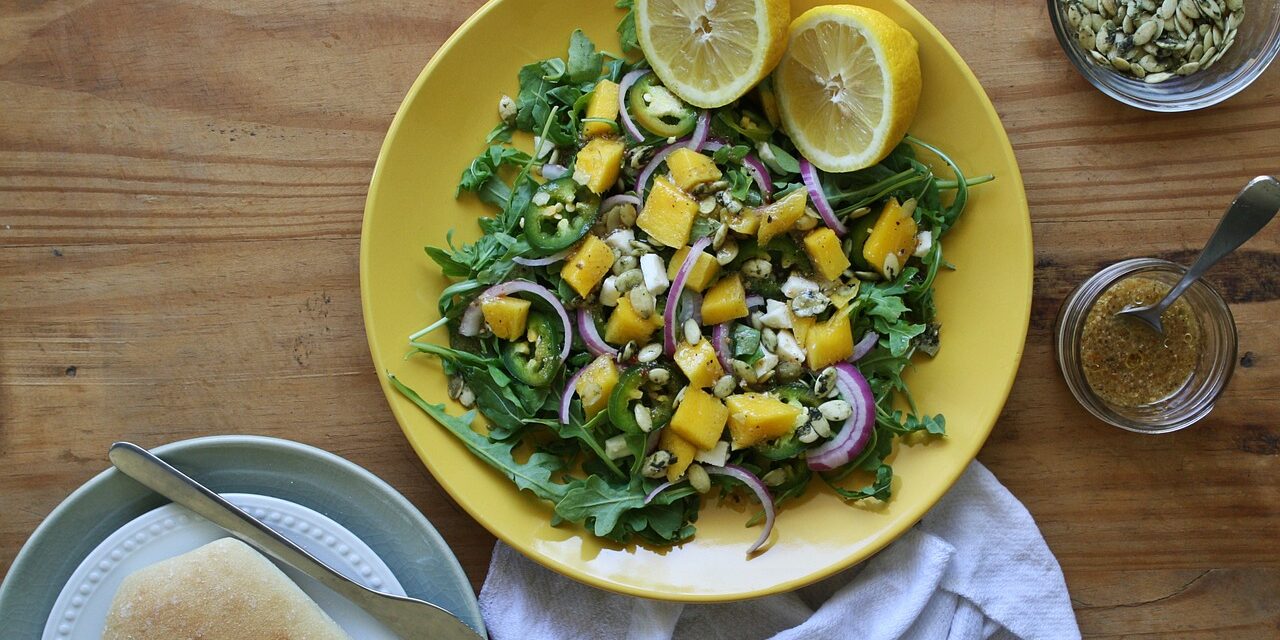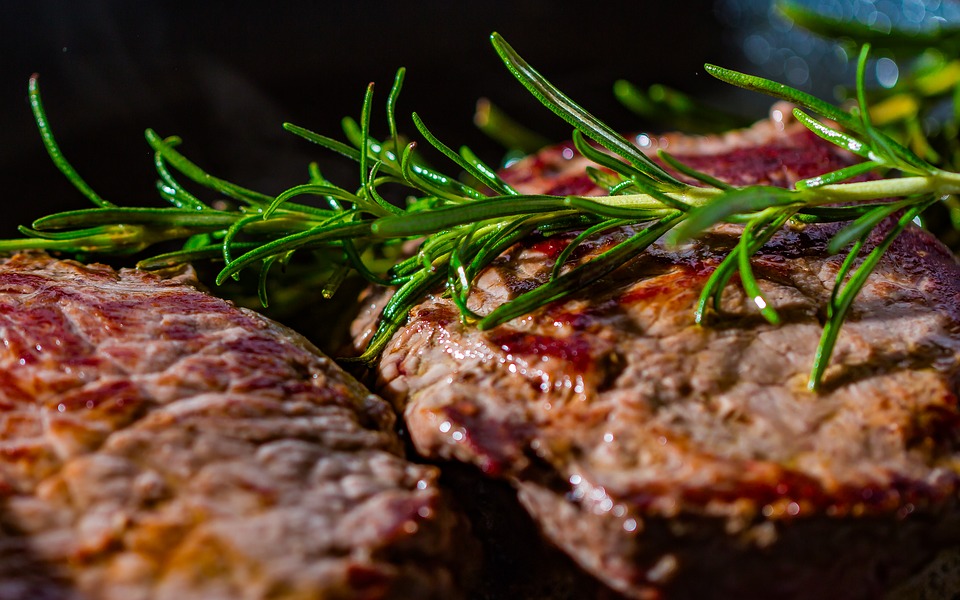I take tremendous pride in being able to offer clients simple solutions to transformation obstacles. But getting enough protein as a vegan or vegetarian is a rare scenario without a simple workaround.
There’s no “tip or trick” that offsets the fact that:
✓ Getting enough protein as a vegan or vegetarian dieter takes much more effort than an “unrestricted” dieter.
This is because there are far fewer lean proteins to work with. Lean proteins have very few calories from carbs and fats (ex. chicken and tuna). Because of this, there’s minimal room in vegan and vegetarian diets for low protein splurges IF the goal is fat loss.
✓ Most vegans and vegetarians don’t get enough protein.
Again, there are few plant-based lean proteins, and there’s a lack of education surrounding actual protein needs for dieters. Many vegans and vegetarians don’t realize the RDA recommendation of .8 grams per kilogram of bodyweight is abysmally low for people interested in improving their health and body composition.
That said, you don’t need as much protein as a jacked up meathead might claim. Per usual, the truth lies right in the middle: at .8 grams of protein per pound of bodyweight* being “best.” Although I often have vegan and vegetarian clients aim for .6+ grams per pound (to make it more realistic).
*With a point of diminishing returns around 120+ grams for women and 160+ grams for men.
✓ Complete proteins—which have all the essential amino acids our bodies need—are much harder to get.
They’re typically found in animal products and few plant-based proteins have them. But it is possible to get enough when including a wide variety of plant-based proteins in your diet. And while some experts suggest combining “complementary proteins”—like whole wheat bread and peanut butter or black beans and rice—in the same meal… this isn’t necessary. Recent research tells us daily intake matters more than how you break it up.
✓ Vegans and vegetarians often experience muscle loss while dieting (when protein demands are higher than usual).
As a result, you might have to diet longer than an “unrestricted” dieter to reach a lower body fat percentage. Here’s a common scenario of how this plays out:
1) Dieter A follows a vegan diet and doesn’t get enough protein while dieting. She loses ten pounds—six of which are fat and four of which are muscle—and reduces her body fat percentage by 2.3%.
2) Dieter B has no dietary restrictions and gets enough protein while dieting. She loses ten pounds—eight of which are fat and two of which are muscle—and reduces her body fat percentage by 3.3%. This is a noticeable difference as you get leaner.
Now Dieter A might have to diet for an additional 3-4+ weeks to achieve the same body fat percentage as Dieter B—and she’ll have less muscle. Less muscle results in:
• A less “toned” look
• Fewer calories burned at rest
• More weight management issues
• A lower strength ceiling
• Reduced quality of life
The list goes on.

At this point, you might wonder if I’m “against” vegan and vegetarian diets—but this isn’t the case. I have no problem with these approaches.* But I also can’t pretend they don’t present unique obstacles.
*Unless you cite ‘What The Health’ as your reason for not eating animal products… then I’ll not-so-subtly roll my eyes and politely bite my tongue.
Fair enough?
Now, let’s get to what you came for: strategies for overcoming these hurdles so you can get results like Jeff (who’s a vegan):
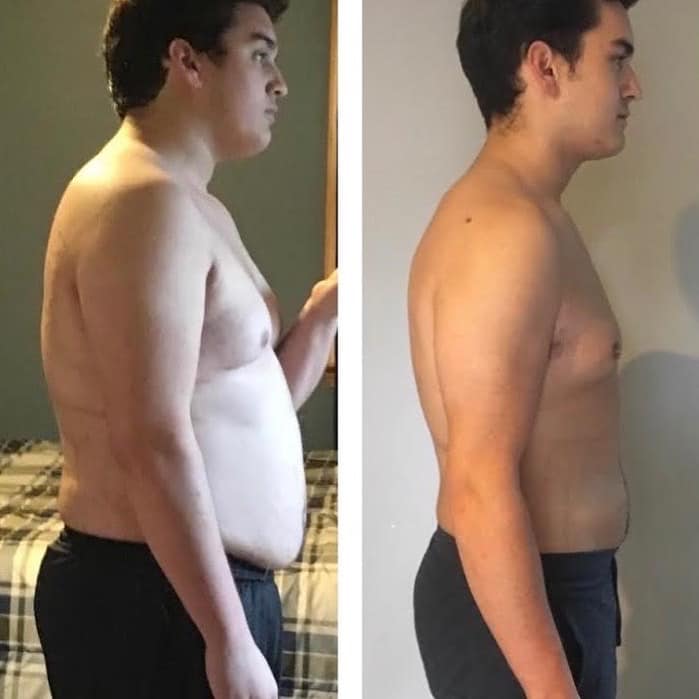
And Carol (who’s a largely plant-based pescatarian):
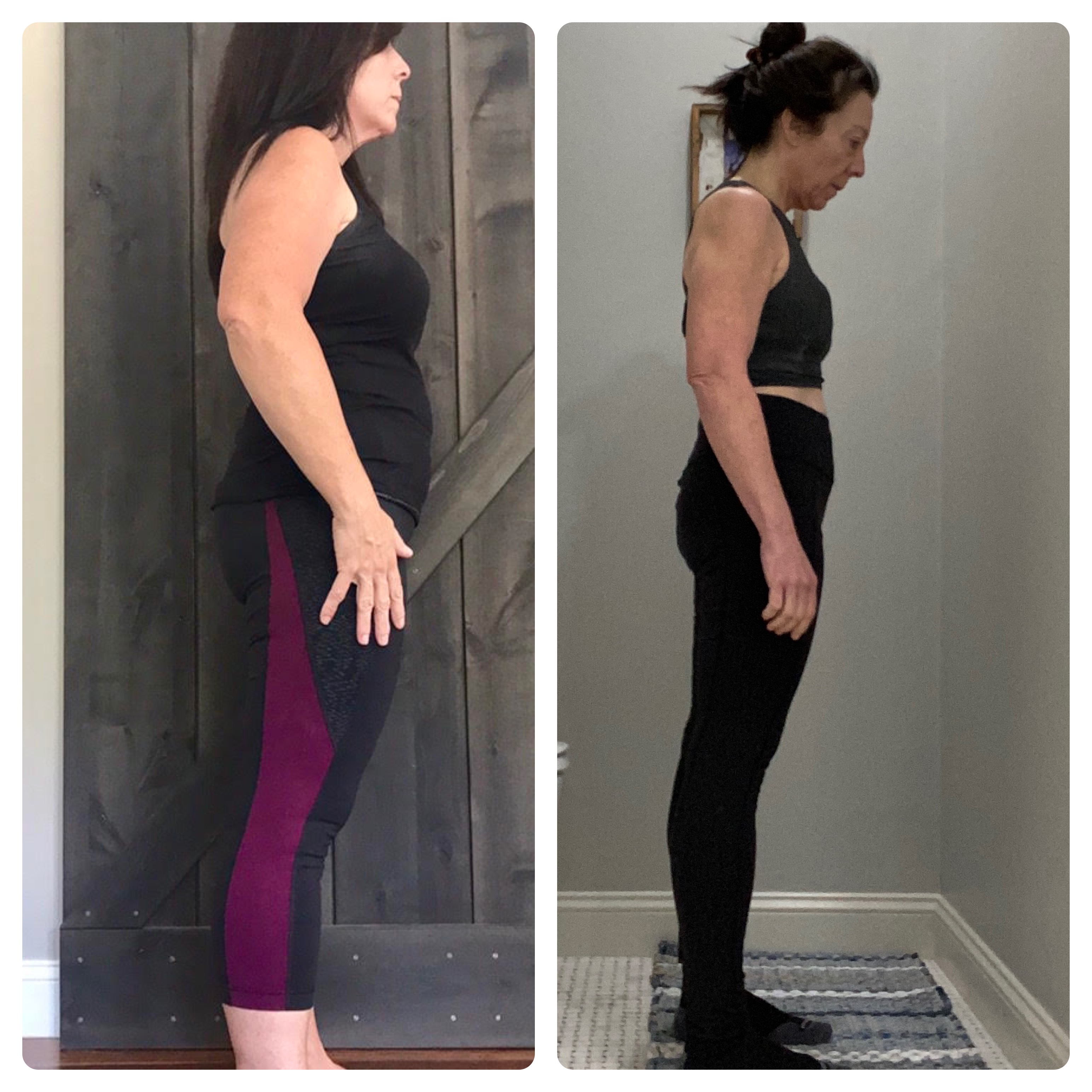
You ready?
1) First, you’ll need to establish your protein minimum
Again, .8 grams per pound of bodyweight is optimal. But I place a much higher premium on attainable—so aim for .6+ grams per pound of bodyweight per day. Here’s what this equates to:
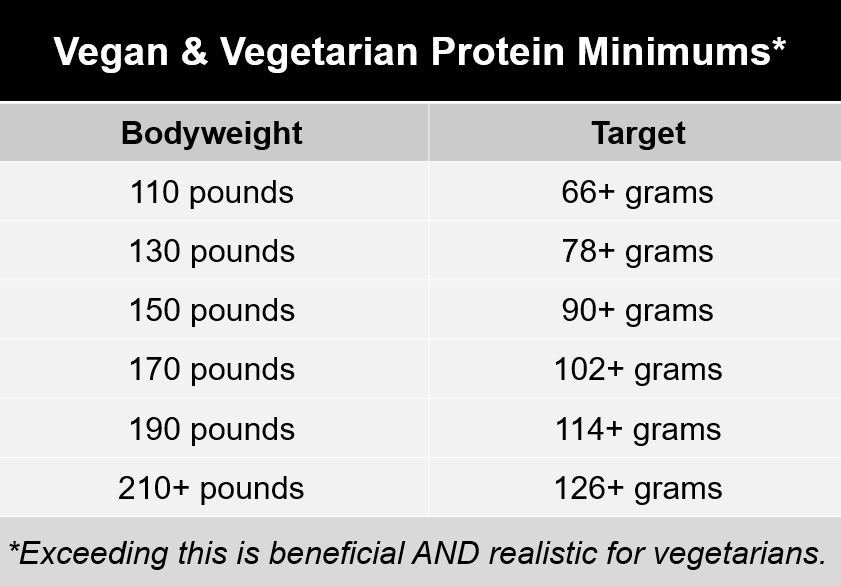
The advantages to exceeding your daily minimum include:
• More muscle retention
• Less cravings and hunger
• Slightly more calories burned day*
And this isn’t hard do hard as a vegetarian dieter if you plan ahead.
*Courtesy of the “thermic effect of food” (the calories burned while digesting protein).
2) Next, you’ll have to get familiar with the best protein sources
If you’re vegan, be prepared for a fairly limited menu:
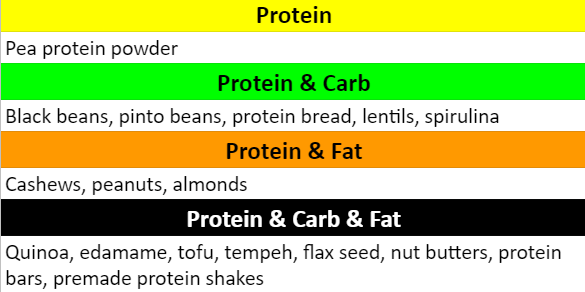
If you’re a vegetarian, you’ll have a few more options to work with:
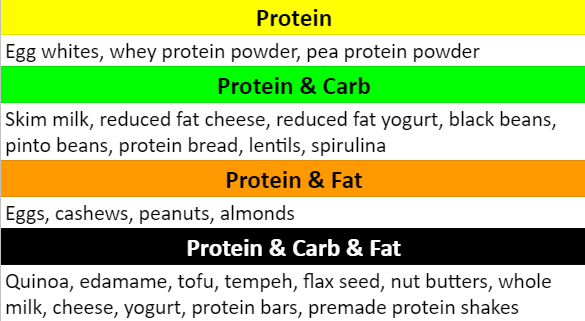
In either case, you need to know these options well. That way, planning is a breeze and there’s little to no guesswork as to how to nail your protein minimum on a regular basis.
3) Then, you’ll want to set aside 3-5 minutes per night to plan the next day’s nutrition
After all, “good days” don’t happen by accident.
Here are ten protein-dense vegetarian-friendly meals and snacks to include in heavy rotation:
✓ Protein smoothie (280 calories and 33 grams of protein): 2-3 minutes
I use 240 milliliters of unsweetened vanilla almond milk, 120 milliliters of water, 2-3 ice cubes, 37 grams of vanilla whey protein, 100 grams of banana, and 50 grams of frozen berries for this.
✓ Scrambled egg whites, whole eggs, diced onions, and an apple (301 calories and 27 grams of protein): 6-10 minutes
Including egg whites with whole eggs is an easy way to keep protein high without too many “extra” calories, as the yoke is comprised of fat.
✓ Hard-boiled eggs and egg whites (121 calories and 17 grams of protein): 12-15 minutes
This is one of the few high protein breakfasts you can prep in advance.
Simply lay 8 eggs (two servings) at the bottom of a pot, fill it with 3-4 inches of water, and bring it to a boil. Once it’s brought a boil, you turn it to a medium heat and let it sit for 10-12+ minutes. Then you can place them in a strainer and run cold water on them (so they don’t cook any more) before deshelling them.
The above totals assume you eat one whole egg, and leave the yolk untouched while eating the other three.
✓ Omelet with onions, tomatoes, and cheese (314 calories and 34 grams of protein): 8-12 minutes
For this recipe, I put two eggs, four egg whites, salt, and pepper into a bowl and whisk it before pouring it onto a pan on a low to medium heat. Once it starts cooking, I add tomatoes and 28 grams of low fat shredded cheese.
Once it cooks a little, I fold the omelet in half, gently press down with the back of my spatula, and wait another minute or two before flipping it and pressing down once more (until it’s fully cooked).
✓ Crustless quiche with vegetables, bacon, and cheese (233 calories and 28 grams of protein per serving): 35-50 minutes
If you’re feeling ambitious, combine three eggs, six whites, diced onions and peppers (OR broccoli), 56 grams of low fat shredded cheese, salt, pepper, and garlic in a big bowl.
Then, spray a small baking dish with olive oil spray (like Pam), and pour the mix in. Finally, put it in the oven (heated at 375 degrees) for 30-40 minutes until the center is no longer “liquidy.” You can test this by sticking a fork in it.
Afterwards, I let it sit on the counter for 1-2 hours, so it settles, and voila: two high protein breakfasts in advance!
✓ Egg white puffs (233 calories and 28 grams of protein per half batch): 25-40 minutes
This isn’t much different than the quiche—except the mix is poured into a muffin pan instead of a small baking dish. Also, it typically bakes faster, because the servings are “packaged” smaller.
✓ Parfait (245 calories and 44 grams of protein per serving): 3-8 minutes
Layer 16 ounces of vanilla Greek yogurt, 8 ounces of chopped strawberries, 8 ounces of blueberries, and 8 ounce of honey granola across three mason jars (or open glasses). This lasts in the fridge for up to two days if it’s covered.
✓ Cottage cheese with pineapples (203 calories and 24 grams of protein): 0-2 minutes
This includes 226 grams of cottage cheese, and 3 ounces of pineapple mixed in a bowl. Admittedly, it can be an acquired taste.
✓ Chobani Greek yogurt with a side of clementines (190 calories and 12 grams of protein): 0-2 minutes
This is a staple in my wife’s diet. She regularly has an individually packaged Chobani Greek yogurt with 6 ounces of clementines as a side. While not overly high in protein, it can put a small dent in your daily minimum.
✓ Low-fat cheese sticks (100 calories and 14 grams of protein per two sticks): 0 minutes
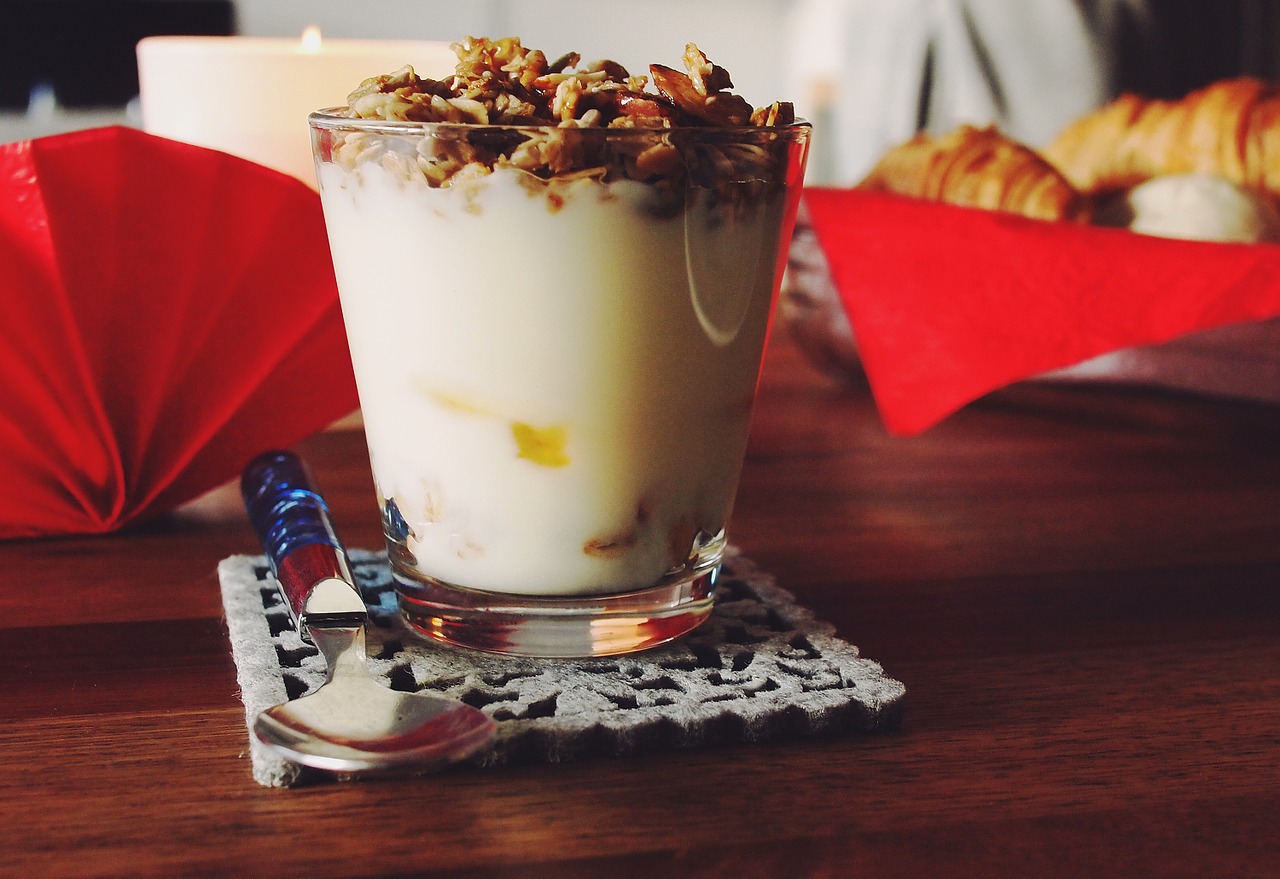
Here are eleven more protein-dense vegan AND vegetarian-friendly meals and snacks:
✓ Protein shake (325 calories and 33 grams of protein): 2-3 minutes
I use 240 milliliters of chocolate almond milk, 120 milliliters of water, 2-3 ice cubes, 37 grams of chocolate peanut butter pea protein, and 100 grams of banana. Occasionally, I’ll add PB2 (powdered peanut butter), which isn’t listed in the above totals.
✓ Energy bites (352 calories and 10.5 grams of protein per serving): 5-10 minutes
While overrated as a high protein breakfast, and “high risk” for being a calorie BOMB, these can be made in a decently fat loss friendly way:
Combine 80 grams of plain oats, 4 fluid ounces of reduced fat peanut butter, 2.5 ounces of ground flaxseed, 2 ounces of chia seeds, 1.5 ounces of honey, and .5 ounces of vanilla extract into a large mixing bowl, and put it in the fridge for an hour or two. Then, take out the mix and separate it into small, rolled balls for breakfast or a snack for the next few days.
✓ Peanut butter and protein bread sandwich (410 calories and 21 grams of protein): 2-3 minutes
This one is simple: put 28 grams of reduced fat peanut butter on two slices of Arnold’s Protein Bread.*
*Some people prefer whole wheat in an effort to get a complete protein.
✓ Scrambled tofu with vegetables (155 calories and 15 grams of protein): 12-18 minutes
Most people prefer using firm tofu for this because it most closely resembles the texture of “real” eggs. After putting an olive oil spray on the pan, you can break up 170 gram’s worth with your spatula. Then you can add sea salt, black pepper, and diced onions and peppers (nutritional yeast is also popular). Finally, mix up the contents of the pan while waiting for it to “dry up.”
Bonus points for adding fruit (which isn’t listed in the above totals)!
✓ Scrambled tofu with vegetables and black beans and rice (494 calories and 28 grams of protein): 12-18 minutes
Follow the same instructions as above, then add ~180 grams of black beans (which are easily cooked with garlic and salt on a low simmer on a separate frying pan for 10-12 minutes) and 2 ounces of jasmine rice (which I typically cook in advance).
✓ Tempeh tacos (~660 calories and 56 grams of protein): 20-30 minutes
For this recipe, you’ll crumble 7.5 ounces of tempeh into a large mixing bowl, along with one serving of nutritional yeast, garlic, sea salt, cumin, and chili powder. A little bit of water can be helpful while mixing these. After you’re done, you’ll put these on a frying pan (coated with olive oil spray) and began cooking.
✓ Tempeh* salad (440 calories and 38 grams of protein): 35-45 minutes
For this salad, you can use romaine or kale as a base (some people use both). Your cubed tempeh (7.5 ounce’s worth) will be cooked in the oven at 375 degrees (on a pan lined with aluminum foil and olive oil spray) for 20-30 minutes after being marinated in lemon juice and garlic for ~10 minutes. You can flip the cubes once about halfway through.
When it’s done, you’ll let it cool off and add 80 grams of chickpea, 20 milliliters of olive oil and herbs (mixed as your dressing), and any other vegetable you enjoy. I like adding a little more sea salt at the end, too.
*At this point, it’s worth noting that tempeh, like tofu, is a soy-based protein, and some people choose to limit this in their diets (although research has shown this may not be necessary when consumed in moderation). If this is the case, you can swap for a chickpea tempeh.
✓ High protein chili (317.5 calories and 19 grams of protein): 35-45 minutes
While extremely healthy, this meal does require a bit of an “extra” effort, because there are a lot of ingredients in this four serving recipe:
• 15 milliliters of olive oil
• 8 ounces of diced onions
• 8 ounces of diced peppers (any color)
• 28 grams of crushed tomatoes
• Seasonings galore (ex. salt and pepper and garlic and cumin and chili powder)
• 32 fluid ounces of vegetable broth
• 12 ounces of quinoa
• 8 ounces of black beans
• 8 ounces of pinto beans
• 1 ounces of lime juice
While there are ways to get fancy with this, I recommend keeping it simple: put everything in a large pot and bring it to a boil. Then reduce the heat to “low” and let it sit for 25-30 minutes.
✓ Pistachios (150 calories and 6 grams of protein): 0 minutes
While not overly high in protein, pistachios are a healthy fat source, and better than the processed junk people consider “healthy” snack food. The above totals are for 28 gram’s worth.
✓ Rise Bars (varies): 0 minutes
In general, I’m not a fan of protein bars, as they often have the nutritional quality of a candy bar and don’t offer much protein for the calories. But Rise Bars are a solid option, with mostly single ingredients, and a little bit of protein, too.
Just don’t put too much stock into any bar (including these), and focus on eating primarily whole foods, instead.
✓ Protein pops (67.5 calories and 8.15 grams of protein per pop): 3-5 minutes
If you want a high protein “dessert,” pour my go-to smoothie’s ingredients (240 milliliters of unsweetened vanilla almond milk, 120 milliliters of water, 2-3 ice cubes, 37 grams of vanilla pea protein, 100 grams of banana, and 50 grams of mixed berries) into a popsicle tray after blending it. Then, put it in the freezer for a few hours and treat yourself to a high protein snack the next few days (the above totals assume you make four pops).

4) Finally, adopt the habits and traits of highly successful vegan and vegetarian dieters (like Jeff and Carol)
These include:
✓ Maintaining a small rotation of protein-dense, low calorie meals that work well for your goals. The alternative—mixing it up daily or near-daily—is not something I’ve ever seen work out. After all, the more decisions you make, the worse those decisions will be.
✓ Having a pea protein smoothie or shake every day. I’ve never spoken to a successful vegan or vegetarian diet who didn’t do this. So it’s something you’ll likely have to commit to and learn to enjoy.
✓ Getting variety from prep styles and seasonings… rather than from the meals themselves. This will be enough to prevent boredom without straying from meals that work well for your goals. My go-to prep tools are my air fryer, George Foreman countertop grill, oven, and crockpot. My go-to seasonings and sauces are:
• Sea salt
• Crushed red pepper
• Ground black pepper
• Garlic powder and salt
• Garlic and herbs
• Almost anything from Grillmates
• Hot sauce
• Lemon and lime juice
I also know many vegans and vegetarians who use Trader Joe’s “Everything But The Bagel” seasoning and nutritional yeast (which has eight grams of protein per serving) on most recipes. None of these have meaningful calories and they ALL give your meals new flavors.
✓ Limiting splurges and processed foods more than you’d like until you reach your goals. This means meat substitutes, and vegan pizza, nachos, and ice cream shouldn’t be in heavy rotation. The same goes for alcohol and snack foods—even if they’re “healthy.”
✓ Operating with tremendous patience and self-awareness, as you chose an approach to nutrition that requires extremely high effort and often hinders physical progress (courtesy of heightened muscle loss). Again, this isn’t bad, and I’m NOT trying to talk you out of it—but you’re also not here for me to sugarcoat things.
That said, there IS a light at the end of the tunnel, as you won’t have to put in this much effort forever. Eventually, food can (and should) become an afterthought when you’re comfortable maintaining. But you need to be comfortable doing what it takes to overcome these obstacles until you reach that point.
Trust me when I say it WILL be worth it.
And I’m always happy to guide you through it.

